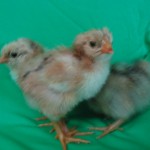Feeding your Chickens in Your back yard
Chickens get yourself a routine for feeding and watering your chickens. This way you will be able to keep and eye on the water and the feed at the same time. Regularly feed and water changes helps to keep disease under control and monitors growth.
Egg laying chicks for the first 6 weeks are fed starter mash. This mix has a good mix of protein at about 20% this will give your chickens a good start. Most good quality chick starter will come with coccidiostat to help prevent coccidiosis. This mash is important for young chickens, they cannot handle whole grains when they are so small, as their digestive system is not developed enough. Try and store your starter mash in a container so that other vermon do not drop their faeces and spread disease. It is best to not over fill your feed tray as this does cause waste. When you top up the feed never put fresh feed over the top of the old food.
Once the chickens reach the 6 week stage you can start feeding them the next stage of food. This is a slightly reduced protein content of around 16% - 17%. If the protein is too high it will mature your pullets too early and force them into egg production before they are fully developed. Change the chicken starter to pullet starter gradually. Mix the 2 together slowly reducing the starter. Approach your local vet for a good mix that you can add to the water to supplement the food for coccidiostat.
Chickens
Once your chickens reach the age of 14 weeks they should then have immunity to coccidiosis as long as you have been using coccidiostat up to this stage.
Now we are looking at 18 weeks and your chickens should be a good size. You can now start your chicken on laying mash, and the protein level should only be around 15%. Other vitamins are of a higher level at this stage. Calcium is now important to young pullets and egg production. As you may have guessed eggs are made up of calcium carbonate. Hens need all the calcium they can get to produce good healthy shelled eggs. You can provide calcium in the form of oyster shell or something similar that is supplied by your local produce, and all you need to do is add this in a feed tray to your pen, your hens will do the rest. (do not feed the hens/pullets extra calcium until they are laying)
Feeding Household Scraps
Scraps from your kitchen, for your hens can be a good advantage. This type of food is not sufficient to solely be the main staple, but can be beneficial to your hen’s diet. So put your waste food to good use and feed them to your flock. Food scraps are very nutritious and enjoyed by your chickens.
Milk and products made with milk, cooked meat, leftover bread or cake as long as it not mouldy. These are just a few of the good type of food scraps that your chickens will enjoy. Try to remember one rule when feeding meat to your chickens, do not include salty meat as this can actually poison your birds. Vegetables peelings don’t carry as much nutrition as the other food scraps, but is a good supply of green feed, and in the winter months when green pick is in short supply, then your vegetables will be a bonus for the chickens. Make sure that your vegetables have been washed as they can be coated in chemicals. So treat the vegetables you feed your chickens with the same respect as you would putting food on your own table.
Feeding too much food scrap, especially food scrap with low nutrition value, can and will effect egg production. The hens will not lay as many eggs, as they have gorged themselves with low nutrition scrap food and don’t leave enough room for nutritious food.
My family have a separate bucket we call our scrap bucket and each day we empty the food scraps to our chickens. They look forward to seeing the yellow bucket come out the back door and race each other to the closest corner of the chicken run.
The young chickens that are not yet at the 8 – 14 week stage we only give them a select small amount as their digestive track may not be able to handle the different texture of each of the scrap food available.
